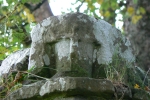RESEARCH into medieval churches that uncovered unique, previously unrecorded findings, including a 13th century medieval crucifixion scene, has been given nearly £500,000 to fund a second phase.
Professor of Medieval and Environmental History, Richard Oram, of the University of Stirling is working with researchers at St Andrew’s University to analyse buildings and sites as part of the Corpus of Scottish Medieval Parish Churches project.
The pilot phase of the project carried out in 2008-9 covered 105 parish churches in the dioceses of Dunkeld and Dunblane. The Arts and Humanities Research Council (AHRC) has awarded a grant of £490,656 to fund the second phase of the project which covers 258 parishes in the dioceses of St Andrews and Brechin.
Professor Oram said the first phase of the study revealed some interesting findings including the discovery that many of the buildings that looked entirely 18th or 19th century were shown to contain surviving medieval fabric.
He added: “At Leny, by Callander, we found surviving pieces of medieval sculptural detail with early 13th century capitals from the columns that went either side of a doorway – one of which had a beautiful crucifixion scene carved on it. These had not been recognised in any previous recording work at the site. It’s helping to give us a much better picture of what the surviving resource is and what conservation issues there may be arising from current land-use, changing building function and environmental change.
“The work carried out in phase one also revealed a lot more building and repair work being undertaken in the decades immediately before the Reformation. This went against the traditional image of that being a period of general decline in standards. It also revealed the existence of a group of highly skilled mason-architects who were responsible for reconstruction at a number of churches – we can now identify work as being the output of particular craftsmen.”
Phase two will start in March 2012 and is expected to take three years to complete. Findings from the project will help to conserve and protect the buildings in the future.
Research from the initial study has already been used by academic and non-academic bodies and it is anticipated that evidence from the second phase will be valuable to community, church and heritage groups, as well as to councils and other stakeholders with a role in the use and preservation of the buildings and sites.
Professor Oram said: “This is a fantastic opportunity to raise public awareness of unique but often neglected architectural gems from our past. I’m most looking forward to unravelling the structural history of some of Scotland’s greatest medieval buildings and potentially rediscovering ‘lost histories’ for some of the lesser-known ones.
“This project will enable us to focus for the first time on a group of buildings that were central to the lives of the entire population – not just the great and the good – and enable us to see how they developed over time, how those developments reflected changes in our ancestors’ expressions of religious faith, and how individuals shaped the development of the buildings.
“The grant will allow us to construct a vast evidence base which will provide the grounding for the historical and architectural reinterpretation of these structures. It will also give us the most substantial body of data yet assembled for developing strategies for the conservation, management and future protection of a major component of Scotland’s historic environment.”
Professor Oram is working on the study with Professor Richard Fawcett and Dr Julian Luxford of the School of Art History of the University of St Andrews. They will be assisted by a PhD student at St Andrews and a post-doctoral researcher at Stirling.
Information and images from the study have been uploaded to the website http://arts.st-andrews.ac.uk/corpusofscottishchurches, where it can be freely accessed. The findings will also be developed into a range of publications and presentations.
ENDS
Notes for Editors .
For further information contact Communications Officer Katy Whitelaw mediarelations@stir.ac.uk or 01786 477058.
MEDIA RELEASE posted by the University of Stirling. You too can post media releases on www.allmediascotland. For more information, email here. And do feel free to follow www.twitter.com/allEducationPR.
Contact: Katy Whitelaw
Phone: 01 786 467058
Email: katy.whitelaw@stir.ac.uk
Website: http://www.stirling.ac.uk






